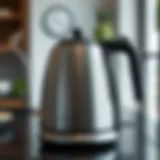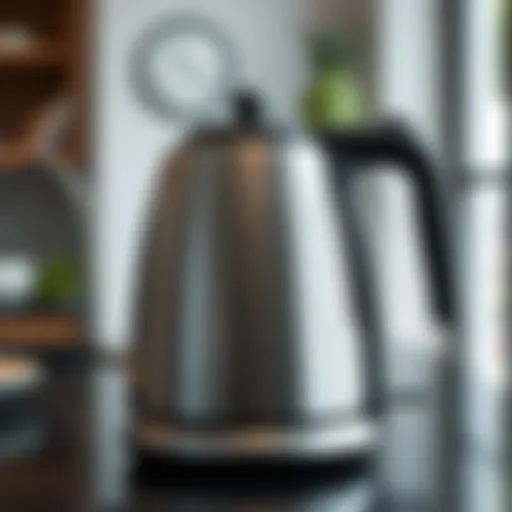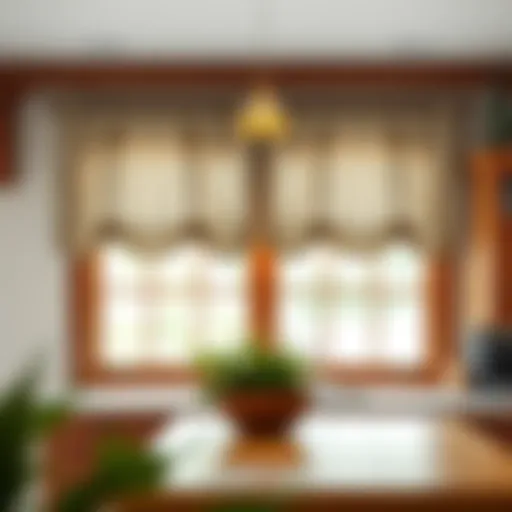Exploring Fabric Wardrobe Closets: Design and Benefits
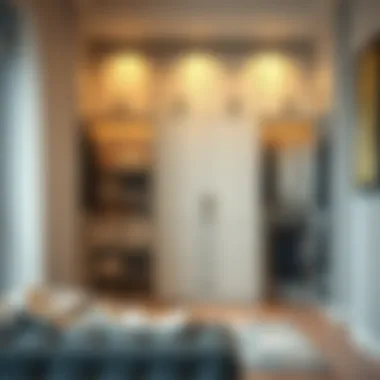

Intro
As we meander through the ever-evolving landscape of interior design, one piece of furniture seems to be catching the eye of homeowners and designers alike—the fabric wardrobe closet. These cozy yet chic storage solutions are not merely functional; they blend style and practicality seamlessly. Unlike conventional wooden wardrobes that can dominate a room, fabric closets whisper elegance without bellowing for attention. They adapt well to the diverse aesthetics of modern homes.
This article will shed light on the many aspects of fabric wardrobe closets, including their rich design possibilities and their practical benefits. Whether you’re freshening up your space or knee-deep in a complete renovation, consider these versatile design elements that can elevate your home organization game. Let's dive right in, unwrapping all the layers that make fabric wardrobe closets a unique addition to any décor.
Furniture Styles and Trends
Modern vs. Traditional: Understanding the Aesthetics
When it comes to furniture styles, fabric wardrobe closets cater to both modern and traditional tastes.
- Modern Designs: These are usually sleek, minimalist, and come in a variety of colors, often with geometric elements. The simplicity of modern fabric closets can enhance an open-plan layout. They can be accessorized with a pop of color or kept neutral to maintain a calming atmosphere. Think about light grey or pastel tones that mirror contemporary aesthetics—these shades can make a room feel spacious and airy.
- Traditional Designs: On the other hand, traditional fabric wardrobes often evoke a timeless charm reminiscent of classic decor. Rich fabrics like velvet or brocade bring a sense of warmth to a space. These closets may incorporate more ornate patterns or colors like deep burgundy or navy blue, establishing a cozy, welcoming environment. It’s about balancing tradition with modern sensibilities, ensuring that it complements the rest of your furniture.
Color and Material Trends: What's In and What's Out
The current trends in fabric wardrobe closets draw from a blend of nostalgia and forward-thinking design.
- In: Earthy tones, such as terracotta, olive green, and soft browns, are reigniting a love for warm, grounded aesthetics. Materials like linen and cotton are favored for their sustainable qualities, making them a hit in today’s eco-conscious world.
- Out: Oversaturated colors and shiny synthetic fabrics have fallen off the radar. Instead of clashing with a room's overall theme, fabric closets now aim to harmonize, subtly contributing to the overall vibe. Avoid going for the bubble-gum pinks unless it's specifically for a child’s room.
The choice of colors and materials ultimately hinges on the personal style of the homeowner while keeping current trends in mind.
Furniture Care and Maintenance
Tips for Prolonging the Life of Your Furniture
Maintaining a fabric wardrobe closet doesn’t have to be a chore. Just a few simple steps can prolong their life considerably:
- Dust Regularly: Use a soft cloth or vacuum with a brush attachment to keep dirt at bay.
- Spot Clean: Accidents happen, and when they do, addressing the spot quickly can save the fabric. Use mild soap and water for minor stains.
- Avoid Direct Sunlight: Keeping your fabric closet away from harsh sunlight prevents fading and preserves the vibrancy of the colors.
DIY Repair Hacks for Common Furniture Issues
Fabric wardrobe closets can suffer from wear and tear just like any other furniture. Here are some handy DIY repairs:
- Patching Up Holes: For small tears, a fabric patch or adhesive can seal things up nicely. Match the fabric for a seamless repair.
- Reinforcing Weak Seams: A straight stitch can do wonders in reinforcing seams that might be coming apart. It can help your wardrobe withstand the test of time.
- Cleaning Discolored Areas: For discoloration, a mixture of vinegar and water can help rejuvenate the fabric.
Such accessible maintenance techniques empower homeowners to take control of their living spaces, ensuring every piece remains quintessentially them.
From exploring trends to understanding how to care for it, fabric wardrobe closets are coming into their own as a transformative element in home organization and design. Dive deeper into the creative possibilities these closets offer, and transform your perception of storage solutions today!
Understanding Fabric Wardrobe Closets
Understanding fabric wardrobe closets is fundamental when discussing modern storage solutions. These versatile furniture pieces merge functionality with style, providing not just a dwelling for clothing but also enhancing the overall aesthetic of a space. This section aims to uncover the significance of fabric wardrobe closets, outlining their practical benefits and varied considerations for potential users.
Definition and Purpose
A fabric wardrobe closet can be defined simply as a storage unit made predominantly from textile materials. Unlike traditional wooden wardrobes, fabric wardrobes are often lightweight and portable, making them an attractive option for those seeking flexibility in their storage arrangements. The purpose of these closets is multifaceted:
- Space Saver: Fabric wardrobes are particularly advantageous in small spaces, as they can be easily relocated or folded away when not in use.
- Lightweight Convenience: Made from lighter materials, they allow for easy transport from one location to another. This is crucial for shoppers who may frequently relocate or simply want to refresh their living spaces without heavy lifting.
- Budget-Friendly: Generally, fabric wardrobes are more cost-effective compared to their wooden counterparts. This affordability opens doors for many homeowners who seek practicality without breaking the bank.
- Versatile Designs: Available in numerous styles, colors, and sizes, fabric wardrobes can adapt to virtually any decor. Whether you're a minimalist or love bold patterns, you can find a design that fits your taste.
For instance, imagine a college student living in a cramped dorm room. A fabric wardrobe can serve as a stylish and functional closet alternative, fitted snugly into a corner while leaving ample room for a study desk. This is just one of the myriad scenarios where these closets shine.
The Evolution of Wardrobe Design
The concept of wardrobe design has transformed dramatically over the years. Originally, wardrobes were large, immobile units made from sturdy woods, often occupying significant floor space. They exuded a sense of permanence and served as a statement piece in a home.
As lifestyles have shifted towards increased mobility and urban living, the demand for flexible storage options has surged. This is where fabric wardrobe closets come into play, marking an evolution in how people perceive and utilize space. Fabric designs are part of a larger trend towards minimalism and adaptability in interior design. Here are some key points regarding this evolution:
- Compact Solutions: The need for compact living solutions has paved the way for lighter, more accessible designs. Fabric closets can fit into small nooks, adjusting to the shifting dynamics of a room's usage.
- Innovative Materials: Modern fabric wardrobes often use advanced materials that enhance durability while maintaining their lightweight profile. This innovation reflects a broader cultural trend that values not just functionality but also sustainability in design.
- Customization and Personalization: The rise of DIY culture has encouraged consumers to seek customized storage solutions. Fabric wardrobes can be tailored to individual preferences, from the choice of fabric to the overall shape, making them a reflection of personal style.
As consumers continue to shift toward more dynamic living environments, the evolution of fabric wardrobe closets will likely follow suit, merging form and function like never before.
Types of Fabric Wardrobe Closets
The realm of fabric wardrobe closets is not as straightforward as it may seem at first glance. This variety provides a wealth of options tailored to different lifestyles and needs. Understanding the types of fabric wardrobes is essential not only for homeowners seeking to declutter but for designers and retailers aiming to cater to diverse markets. Here, we unravel the unique characteristics of portable options, built-in designs, and modular systems—all of which offer their own set of benefits and considerations.
Portable Options
Portable fabric wardrobe closets are a game-changer for those seeking flexibility combined with functionality. As the name suggests, these closets can be easily moved from one spot to another, making them ideal for renters or anyone frequently rearranging their living space. Whether it's an apartment in the city or a temporary living situation while traveling, a portable wardrobe can fit almost anywhere.
Some of the advantages of portable fabric wardrobes include:
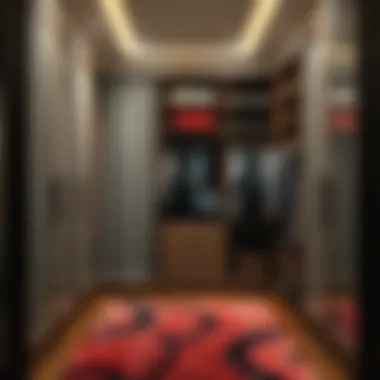

- Lightweight Construction: Most portable options are made from lighter materials, making them easy to transport and set up without heavy lifting.
- Quick Assembly: These wardrobes often feature simple assembly instructions and can be set up in under an hour, saving time and causing less hassle.
- Versatile Use: They can serve various purposes, such as storage for clothes in a guest room or even as a makeshift closet during events like camping.
On the downside, portability tends to compromise stability. Therefore, it is vital to consider weight distribution when filling these closets. An uneven load can lead to tipping or sagging over time.
Built-in Designs
Built-in fabric wardrobe closets present a more permanent solution for homeowners looking to integrate storage seamlessly into their existing decor. These closets are designed to fit perfectly into a designated area, often taking advantage of every nook and cranny in a bedroom or hallway.
Key benefits of built-in designs include:
- Custom Fit: Built-ins can be tailored to the dimensions of the space, ensuring optimal use of available area, especially in smaller homes.
- Enhanced Aesthetics: A well-designed built-in can elevate the overall look of a room, blending with your furniture and theme.
- Improved Durability: With sturdier construction, built-ins can withstand heavier loads compared to portable models.
However, they usually require a higher investment, and installation may often involve cutting into walls or making more substantial adjustments to your space. For those looking for elegance paired with functionality, built-in options might be the way to go.
Modular Systems
Modular systems represent an exciting approach to fabric wardrobe closets, allowing for personalization and future expansion. These units consist of various components that can be rearranged and modified according to needs. You might encounter shelves, drawers, and hanging spaces that fit together like building blocks.
Benefits of modular systems include:
- Adaptability: As needs evolve, the modular design enables easy reconfigurations—perfect for growing families or changing fashion preferences.
- Customizable Layouts: Users can design their storage spaces based on their unique habits, such as prioritizing hanging space for formal attire or shelf space for shoes.
- Scalable: Need more storage down the road? Simply add more modules to your existing system instead of starting from scratch.
Nevertheless, results can vary widely based on manufacturer quality. Therefore, it’s important to research reputable brands known for durability. Furthermore, care should be taken to ensure all components fit snugly together—improper assembly can lead to instability and reduced functionality.
"Understanding these diverse types of fabric wardrobe closets equips homeowners with the knowledge to choose a solution that best meets their aesthetic desires and lifestyle needs."
In summary, the options that are available when it comes to fabric wardrobe closets are vast and versatile. Selecting the right type depends heavily on the specific needs of the user and the context of the living space. Taking the time to understand each type will pave the way for a more organized and stylish environment.
Materials Used in Fabric Wardrobe Closets
When considering fabric wardrobe closets, the materials used in their construction carry immense weight. The right fabric not only influences the overall aesthetic appeal but also shapes the functionality and lifespan of the closet itself. It’s not merely about selecting a pretty pattern or color; it delves into how these materials interact with household environments, resist wear and tear, and contribute to a sustainable lifestyle. By thoughtfully selecting the fabric, one can enhance both the look and utility of their wardrobe closet.
Choosing the Right Fabric
Selecting the appropriate fabric for a wardrobe closet is akin to choosing the right ingredients for a signature dish. Different fabrics come with distinct characteristics that can make or break the closet’s performance.
- Canvas: Renowned for its durability, canvas stands tall against everyday wear and tear. This heavy-duty option is particularly great for portable wardrobes, ensuring they can handle a good amount of weight without sagging.
- Polyester: This synthetic fabric has gained popularity due to its resistance to wrinkles, fading, and even mildew. For those living in humid or wet climates, polyester can be a smart choice, offering both practicality and easy care.
- Cotton Blends: If you're after breathability, cotton blends are worth considering. They offer a softer touch, making them ideal for interior wardrobes that are frequently accessed.
It's crucial to assess the specific needs of your wardrobe context. In essence, the fabric should align with both aesthetic desires and functional requirements.
Durability Factors
Durability does not merely equate to the fabric’s ability to withstand time – it encompasses many elements that ensure a fabric wardrobe closet stands the test of daily use. Various factors play into how long the chosen fabric will last:
- Thread Count: Generally, a higher thread count contributes to greater durability. Fabrics with tightly woven threads can resist wear and tear, making for a longer-lasting wardrobe solution.
- UV Resistance: For closets exposed to sunlight, considering fabrics with UV resistance can prevent fading, ensuring your wardrobe keeps its color and integrity over the years.
- Water Resistance: Some fabrics come with water-repellent finishes, which can be beneficial, especially in areas prone to spills or moisture.
In short, a proper evaluation of these factors can significantly influence the longevity of the closet.
Sustainable Material Options
As awareness grows around sustainable living, selecting eco-friendly materials for fabric wardrobe closets becomes paramount. Homeowners and designers alike are increasingly drawn to options that reduce environmental impact without compromising on quality:
- Bamboo Fabric: Noted for its rapid growth and renewability, bamboo fabric is a fantastic sustainable alternative. It’s both soft and durable, appealing to those looking for eco-conscious solutions.
- Recycled Polyester: This option utilizes discarded plastics, transforming them into functional fabrics. It meets durability needs while also benefiting the planet.
- Organic Cotton: Grown without harmful pesticides and chemicals, organic cotton is a healthier alternative for both the wearer and the environment. It promotes better soil health and reduces water usage in its production.
By opting for these green materials, individuals can blend functionality with responsibility toward the planet.
"Choosing sustainable materials is not just about providing a product; it’s about cultivating a lifestyle that thrives on conscientious decisions and respect for our surroundings."
In summary, the choice of materials in fabric wardrobe closets ranges from practical considerations of durability to a commitment to environmental sustainability. Each decision contributes to a cohesive understanding of how these wardrobe closets function within a home and reflect broader lifestyle choices.
Functional Aspects of Fabric Wardrobe Closets
When diving into the realm of fabric wardrobe closets, understanding their functional aspects is pivotal. These systems are not merely decorative; they serve vital roles in optimizing space, enhancing organization, and providing easy accessibility. Unlike traditional wooden wardrobes, fabric closets bring depth in terms of functionality and can adapt to various needs and living spaces. The focus here is on how these closets maximize storage, offer organization solutions, and include features that make accessing belongings a breeze.
Maximizing Storage Capacity
One of the standout features of fabric wardrobe closets is their ability to maximize storage capacity. They often utilize vertical space more efficiently than conventional options due to their lightweight and flexible nature. With a variety of compartments, shelves, and hanging rods, homeowners can configure their setup to suit their specific needs. This adaptability makes them particularly advantageous in urban settings where square footage might be a luxury.
- Vertical space utilization: Tall fabric closets allow for piles of clothing upwards, which might be wasted in a typical wardrobe. You can stack bins or boxes at the top for items not used daily.
- Multi-purpose functionality: Many models can serve as a closet and storage for shoes, accessories, or seasonal items. It becomes easier to switch wardrobes with the seasons without cluttering space.
- Customizable sections: Some fabric closets come with adjustable shelving and hanging bars, letting users modify the layout according to changing styles or items.
Organization Solutions
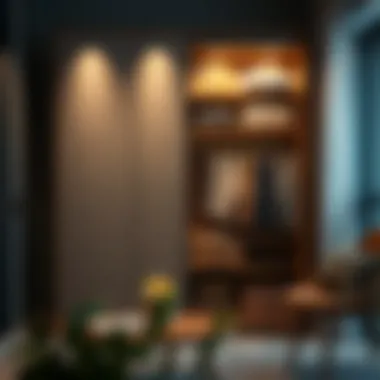

When it comes to organization, fabric wardrobe closets shine through their design. They often include options like zippered compartments, transparent pockets, and modular inserts that cater specifically to the needs of the user. The ability to segregate items leads to reduced clutter and a sense of order in one’s personal space.
- Transparent pockets: These allow you to see what's inside without digging through a bag or drawer, saving time in choosing outfits.
- Zippered compartments: Ideal for storing delicate items or out-of-season clothing without exposure to dust, keeping them in top condition until needed again.
- Modular inserts: Designed to accommodate different clothing types—from dresses to shoes—these inserts help in maximizing every inch of the fabric closet.
Easy Accessibility Features
Accessing your belongings shouldn’t feel like a hassle. Fabric wardrobe closets often include features that promote ease of movement and selection. Their open-sided design can make it simpler to reach items without needing to skirmish through numerous layers of clothes.
- Rolling racks: Some fabric closets come with integrated rolling racks enabling the user to push clothes aside without removing everything at once.
- Drawer systems: Drawers designed into fabric closets easily hold smaller items like accessories or folded garments ensures nothing gets lost in the fray.
- Lightweight flexibility: Easier to maneuver than their wooden counterparts, many fabric wardrobes are pram-like, letting you wheel out certain items or sections as needed.
"By creating a seamless blend of style and practicality, fabric wardrobe closets address modern storage challenges while enhancing home organization."
Offering a thoughtful and comprehensive understanding of the functional aspects allows homeowners to perceive the full value of incorporating fabric wardrobe closets into their living spaces. As you manage the various elements—maximizing storage, providing effective organization solutions, and ensuring easy access—you redefine your relationship with your belongings, making everyday routines smoother and more efficient.
Design Elements to Consider
When selecting a fabric wardrobe closet, the design elements really can make or break your choice. These elements influence not just how the closet looks but also how effectively it fits into your space and serves its purpose. Key considerations in design range from color and aesthetics, to overall integration into your home’s interior scheme, and opportunities for personalization. Understanding these design elements will empower homeowners and designers alike to create a closet that is both functional and appealing, ensuring it enhances the overall environment of your space.
Color and Aesthetics
The color scheme of a fabric wardrobe closet plays a pivotal role in the overall aesthetics of a room. Hues can evoke different feelings—soft pastels can create a calming atmosphere, while bold colors can inject energy into the space. One must consider the existing color palette when choosing a fabric wardrobe. For instance, if your room has neutral tones, opting for a vibrant color can provide an eye-catching focal point, whereas a fabric that mirrors these tones can create a seamless blending effect.
To really nail the aesthetic, pay attention to patterns as well. Stripes, florals or even geometrics can leave lasting impressions. However, it’s prudent not to overwhelm the room. When selecting, think of the story you want your space to tell—cozy rustic or sleek modern?
"The color of the fabric wardrobe should not just be a decision based on preference but also one that ties the room together, creating a harmony that’s both pleasing and inviting."
Integration with Interior Design
A fabric wardrobe closet must work with the surrounding décor for optimal effect. Proper integration goes beyond mere color coordination; it involves understanding the style of other furniture, architectural elements, and even accessories in the room. If you have vintage furniture, a contemporary fabric wardrobe might feel out of place. Conversely, a retro-styled wardrobe can harmonize beautifully with classic furnishings, creating a coherent aesthetic.
When contemplating integration, consider the materials involved as well. A wooden wardrobe can clash with metal finishes found in modern decor. Choosing a fabric that introduces textiles harmoniously with other materials can enhance the overall design—consider cottons or linens that can bridge various elements together without overshadowing them.
Personalization and Customization
Personalization transforms a fabric wardrobe closet from something ordinary into an extension of your style. Most options allow you to customize size, layout, or shelving to suit individual preferences. Need a specific height for your dresses? Want a dedicated compartment for shoes? A well-thought-out fabric wardrobe closet allows you to ditch the cookie-cutter designs and get something that serves you perfectly.
Additionally, fabric options allow for even greater personalization. Perhaps your favorite color is navy or you adore a particular floral design. Incorporating unique fabric swatches not just showcases your taste but also allows the wardrobe to become a statement piece in the room.
Furthermore, consider adding functional elements like hooks or additional shelves based on what you plan to store. Personalization isn’t just about looks; it is about creating a system that enhances everyday living.
By giving careful thought to these design elements, you can craft a fabric wardrobe closet that fits not just your organizational needs but also works harmoniously within your home’s design framework.
Installation and Maintenance
The installation and upkeep of fabric wardrobe closets can often be overlooked in the excitement of selecting a design that fits your style and organization needs. However, understanding the nuances of installation and maintenance is crucial for achieving optimal functionality and ensuring the longevity of your investment. Properly installed, these closets can transform a chaotic space into a haven of order, providing ease of access to your belongings while maintaining aesthetic appeal. The importance of this topic lies in the fact that even the most beautifully crafted closet won’t serve its purpose if it's not set up correctly or cared for regularly.
Installation Tips and Guidelines
To kick things off, here are a few tips to ensure that your fabric wardrobe closet is properly installed:
- Choose the Right Location: Before installation, consider where you want this closet to reside. Is it going in a bedroom, guest room, or perhaps a shared space? Ensure it will be in an area that's not only convenient but also complements the overall flow of the room.
- Follow Instructions Carefully: Whether you’re working with a portable fabric closet that’s easy to assemble or a bespoke built-in design, be sure to follow the manufacturer's guidelines meticulously. Each model might have unique installation requirements, so misplacing a step can lead to complications and even damage.
- Use the Right Tools: Basic tools such as a screwdriver, hammer, and level can go a long way. Make sure you have everything on hand before diving into the installation process to prevent interruptions.
- Assess Stability: Once installed, check for stability. A flimsy wardrobe, especially if it’s bearing a lot of weight, is not only inconvenient but can also be unsafe.
- Secure Against Wall: If space allows, anchoring your fabric wardrobe against a wall can provide additional support, especially for larger setups. This reduces the risk of tipping over and gives peace of mind about your belongings.
Cleaning and Care Techniques
Keeping your fabric wardrobe closet clean and well-maintained is easier than you might think. Here are a handful of techniques to consider:
- Regular Dusting: Dust can accumulate quickly, affecting the appearance and cleanliness of your closet. Use a damp cloth to wipe down surfaces once a month, focusing on areas that might not be visible at first glance.
- Spot Cleaning: Accidents happen. If you notice any stains, be proactive. Use a fabric cleaner or a mild detergent mixed with water. Test in a small area first to prevent discoloration.
- Vacuuming or Brushing: For fabric surfaces, a vacuum with a brush attachment or a lint roller can effectively remove dirt and dust. This should be part of your regular cleaning routine, ensuring the fabrics remain vibrant and fresh.
- Seasonal Overhaul: Every change of season, take the time to evaluate what’s in your wardrobe. Rotate seasonal items, removing those you no longer wear or need. This simple act can drastically improve organization.
Longevity Considerations
When it comes to keeping your fabric wardrobe closet around for the long haul, consider these factors:
- Material Quality: From polyester blends to cotton, the fabric material influences durability. Opt for high-quality materials, as they typically resist wear and tear better than cheaper alternatives.
- Climate Conditions: Mind your local climate. Excess humidity or dry air can harm the integrity of your closet. A dehumidifier or an air conditioning unit can help maintain an appropriate environment.
- Weight Distribution: Be mindful of how you place items within the closet. Balance heavier pieces towards the lower sections and lighter items above to prevent sagging or strain on fabric.
"A well-cared-for wardrobe closet is not just an investment in organization but a gateway to a more pleasant daily routine."
In summary, focusing on installation and maintenance does pay off. It elevates the aesthetic of your space while keeping everything tidy and accessible. Not only can you prolong the lifespan of your fabric wardrobe closet, but you also enhance its functionality, making your daily experiences far more enjoyable.
Trends in Fabric Wardrobe Closets
Understanding the latest trends in fabric wardrobe closets is not just a passing fancy for today's homeowners and design enthusiasts; it’s about embracing a storage solution that aligns with modern living. As our lifestyles evolve, so do the necessities of home organization, and fabric wardrobe closets are stepping up to the plate. This section will shine a light on key trends that are reshaping this niche, exploring their implications and benefits while also dissecting innovative features that are proving to be game changers.
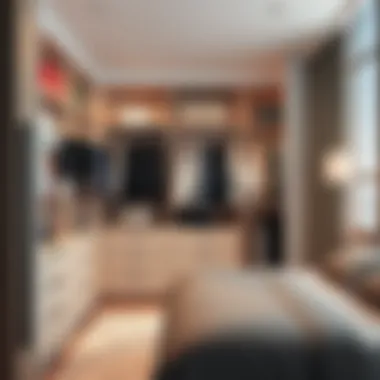

Current Industry Trends
Today, fabric wardrobe closets are making waves for a myriad of reasons. Here are some notable trends:
- Natural Materials: There’s been a notable shift towards using sustainable and eco-friendly materials in the construction of fabric wardrobes. From organic cotton to recycled polyester, today’s consumer is looking more towards options that minimize environmental impact.
- Custom Designs: More homeowners are opting for bespoke solutions, tailored to fit their unique spaces and personal tastes. This trend allows for a more personalized approach where styles vary, making rooms feel cozier.
- Multi-Functional Spaces: As homes become more integrated with work and leisure activities, fabric wardrobes are designed to serve multiple purposes. For instance, wardrobes can double as office storage or even display areas for decorative items.
- Minimalism: This has become a prevailing philosophy in design. Fabric wardrobe closets, with their sleek lines and uncluttered look, align well with this trend, helping homeowners achieve a more serene living environment.
Innovative Features
The innovation train doesn’t slow down when it comes to fabric wardrobe closets. Several features are cropping up that not only enhance functionality but also elevate the design aesthetic:
- Smart Technology: With the rise of the smart home, fabric wardrobes are not left behind. Integrated lighting, climate control, and even automated doors are making their way into these organizational tools, offering a level of convenience that is hard to beat.
- Adjustable Components: Customizability is becoming a staple. Features like adjustable shelving, removable rods, and interchangeable fabric covers provide users flexibility to adapt the space as their needs change.
- Integrated Charging Stations: Modern wardrobes now often include built-in charging ports for phones and other devices, combining form and function like never before.
- Space-Saving Features: From foldable designs to compact modular styles, today’s options cater to homes of all sizes. These solutions enable users to maximize closet space without compromising on aesthetics.
"Innovation in design is not just about what we see, but also about how we interact with our spaces."
In essence, the growing trends in fabric wardrobe closets reflect a lifestyle that values sustainability, flexibility, and integration, catering to an audience that seeks not only utility but also a sense of style in their organizational solutions. With ongoing innovation, these spaces are likely to evolve even further, beckoning the future with their promise of comfort and elegance.
Cost Considerations
When it comes to incorporating a fabric wardrobe closet into your living space, understanding the costs involved is crucial. It not only helps in budget planning but also in ensuring that the investment aligns with both your functional needs and aesthetic desires. Whether you’re a homeowner looking to maximize the space in a small apartment or a designer aiming to create a stylish, organized environment, cost considerations play a key role.
For many, initial costs might be daunting, but it's important to look at the broader picture. Consider the long-term value that a fabric wardrobe closet can provide. While some might envision hefty price tags, there are affordable options that don’t skimp on quality. These cost-effective solutions often deliver versatility and functionality appropriate for various lifestyles.
Budget-Friendly Options
When exploring budget-friendly fabric wardrobe closets, it helps to keep a few pointers in mind.
Here are some options worth considering:
- Portable Wardrobe Systems: These are often lighter on the wallet while providing decent storage space. They can be moved easily and adapted to your changing needs.
- DIY Fabric Wardrobes: A blend of creativity and practicality, DIY wardrobes can significantly cut costs. With just a few materials like fabric, wooden rods, and some simple tools, one can build a custom closet tailored to specific needs.
- Sales and Discounts: Keep an eye out for seasonal sales or clearance events. Retailers may offer significant markdowns on last season’s inventory, making it a good moment to buy a durable fabric wardrobe at a lower price.
By approaching wardrobe shopping with an eye for affordability, you’re not just saving a dime, but opening up new possibilities for your overall design.
Investing in Quality
While being budget-conscious is a sound strategy, it’s equally important to consider the value of investing in higher-quality fabric wardrobe closets. Spending a little more upfront can save you headaches in the long run. Here’s why:
- Durability: Quality fabrics and materials stand the test of time. They won’t wear down easily under the strain of clothing and everyday use, translating into savings on replacements.
- Functionality: Premium options often come with enhanced features such as better organizational tools, sturdy frames, and improved designs, making daily use a pleasure rather than a chore.
- Aesthetic Appeal: An investment in quality often brings with it superior design features, contributing to the overall look of your space. A sleek fabric wardrobe can serve as a focal point, blending function with style seamlessly.
Case Studies and Examples
Case studies and examples provide a practical lens through which to examine the concepts discussed in the overarching topic of fabric wardrobe closets. They showcase real-world applications, revealing how various designs and materials function in different settings. Understanding these cases enlightens homeowners, designers, and retailers about the adaptability and effectiveness of fabric wardrobes in practice. Additionally, it helps in evaluating not just the aesthetic appeal but also the functional benefits of these closets.
Residential Applications
A compelling residential application of fabric wardrobe closets can be found in urban apartments where space is often at a premium. Traditional wooden wardrobes can be bulky and leave little room for creativity in small spaces. For instance, a couple living in a compact studio in New York transformed their closet situation using a fabric wardrobe from IKEA. They opted for a lightweight, portable fabric design, which allowed them to maximize their limited square footage. This choice not only provided ample storage for clothing but also included compartments for shoes and accessories, solving their organizational challenge effectively.
Moreover, the couple painted the fabric wardrobe a bright teal, complementing their decor and making it a focal point rather than an eyesore. It demonstrates how a fabric wardrobe can blend functionality with personality in a home. From a practical standpoint, there are numerous benefits of this setup: the ability to relocate it easily if they decide to move, the variety of colors and designs available that match personal styles, and the lower cost compared to solid wood options. Such choices reveal the emerging trend of flexible living spaces.
Commercial Usage
Fabric wardrobe closets aren't just for homes; they also shine in commercial environments. Take, for example, a boutique hotel in San Francisco that integrated fabric wardrobes into their room designs. Instead of traditional dressers, each room featured a sleek, modern fabric wardrobe that offered easy access to garments, towels, and linens for guests.
These wardrobes could be customized in alignment with the hotel's unique branding, featuring bold colors and fun patterns that complement the overall aesthetic of the space. Each wardrobe was strategically placed to maximize flow in the room, promoting convenience for guests who value both functionality and style.
From a business aspect, the hotel found that flexible and lightweight wardrobes were easier to transport, allowing for various configurations of the rooms as they sought to adapt to changing customer demands. Simple, elegant, and functional, these fabric wardrobes not only met the storage needs of the guests but also reinforced the hotel’s commitment to innovative design without compromising on guest experience.
"Incorporating fabric wardrobes into both residential and commercial spaces highlights their versatility and capacity to meet diverse storage needs while enhancing overall aesthetic appeal."
Overall, both residential and commercial examples underline how fabric wardrobe closets can effectively address space constraints, providing stylish solutions that resonate with today's needs. By examining various case studies, stakeholders can leverage insights to inform their decisions about incorporating these spaces into their own designs.
Finale
The conclusion of this article serves as a critical synthesis point, highlighting the expansive role fabric wardrobe closets play in modern living spaces. Not just simple storage solutions, these closets serve to merge functionality with design, making them not only practical but also aesthetically pleasing additions to any home. As we’ve explored, the diversity in materials and designs offers homeowners a plethora of choices tailored to their unique needs and preferences.
Summarizing Benefits
- Space Maximization: Fabric wardrobe closets are savvy solutions for small spaces, capable of fitting in tight corners and nooks without overwhelming the room.
- Affordability: They often come at a fraction of the cost compared to wooden built-ins, allowing homeowners on tighter budgets to invest in quality storage that meets their needs.
- Versatility: With various designs available that blend seamlessly into different decor styles, fabric wardrobe closets can adapt to various settings, from contemporary to rustic.
- Easy Maintenance: Fabrics used in wardrobe closets are generally easier to clean when compared to traditional materials. Most can be wiped down or gently washed, ensuring they maintain a fresh appearance over time.
One cannot overlook the importance of sustainability either. Many options available now are made from recycled or eco-friendly fabrics, underscoring the move towards more responsible consumer choices.
Future of Fabric Wardrobe Closets
The future of fabric wardrobe closets appears bright, driven by increasing consumer awareness to sustainability and multifunctionality. Advanced technology in textile manufacturing is leading to the development of more durable and diverse fabric options. Innovations such as moisture-wicking and antimicrobial properties in materials are just the tip of the iceberg.
- Smart Storage Solutions: The integration of technology will continue to shape storage spaces. Imagine intelligent closets with built-in sensors that track clothing inventory or app-enabled functionalities to help users manage their wardrobe effectively.
- Customization Trends: As personalization becomes a defining trend, we can expect more brands to offer modular systems that you can tailor to fit individual spaces perfectly. From colors to sizes, every aspect can become personal, making wardrobe closets uniquely yours.
As we look ahead, it’s clear that fabric wardrobe closets will not merely be seen as a trend but as a staple in the design and functionality of living spaces, appealing to the needs of a discerning, eco-conscious consumer base.
Ultimately, the insights gathered from this exploration serve to guide homeowners, designers, and organizers alike in making informed decisions about their storage solutions - harnessing the blend of style and utility that fabric wardrobe closets promise.
